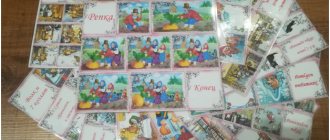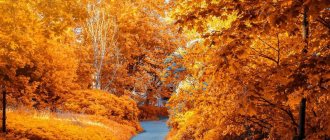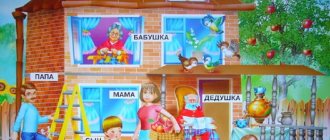Program content:
Expand and clarify knowledge about the life of wild animals, their appearance and way of life; consolidate generalizing concepts in speech: “wild animals”; improve the grammatical structure of speech, practice the formation of nouns with the suffix - at, - yat (baby animals); to develop interest in the poetic word; to cultivate in children love and respect for nature: the forest and its inhabitants (wild animals); develop coherent speech and speech hearing in children; develop visual attention, memory, thinking and imagination of children; develop children's mental activity.
Vocabulary work: wild animals.
Preliminary work: reading works of art, looking at illustrations, conversations and observations.
Material: illustrations, envelope with letter.
Progress of the lesson:
Organizing time
Children, what time of year is it now? (Spring) What happens in nature in spring? (I'm generalizing)
- Spring is coming towards us with quick steps
- And the snowdrifts melt under her feet.
- Black thawed patches are visible in the fields
- You can see very warm feet in spring...
I. Tokmakova
Surprise moment
And on such a spring day, an unusual event occurred in our group. When I entered the group in the morning, there was an envelope on the table with a letter in it. Listen to him. “Dear children, we invite you to visit us in the forest. Wild animals".
Shall we go for a visit, into the forest? What animals can we meet in the forest? (List) Why are these animals called wild (They take care of themselves) What happens in the life of wild animals in the spring? (They awaken and have cubs).
Well done! You know a lot, then hit the road! Just remember that the forest is a home for birds and animals, and we are guests in it, so you need to behave well so as not to scare the inhabitants of the forest.
(Children get up, one after another follow the teacher) We say together: “We are going to the spring forest, it is full of different miracles.”
Coordination of speech with movement
How easy it is to breathe in the spring forest, let's do some exercises.
- We have a nice posture, we have brought our shoulder blades together,
- We walk on our toes and then on our heels.
- Let's go softly, like little foxes and like a clumsy bear,
- And like a gray wolf - a little wolf, and like a bunny - a coward.
- The hedgehog curled up into a ball because he was cold.
- The ray touched the hedgehog, the hedgehog stretched sweetly.
Guessing riddles (Development of speech hearing, thinking)
These pictures show wild animals that invited us to visit (the pictures are turned face inward). Guess who it is? (the teacher asks riddles, and after guessing, turns the picture to face the children).
1. In a dense forest, under a fir tree, covered with leaves, lies a ball of needles, prickly and alive. (Hedgehog)
Who is this? What hedgehog? What kind of fur coat does he have? Why does he need such a fur coat? What if you undress the hedgehog? What will happen to him?
2. The clumsy clubfoot who sucks his paw all winter? (Bear)
Who is this? How did you guess? What does a bear do in the spring? What does a bear look like? What does a bear eat?
3. I wear a fluffy fur coat and live in a dense forest. In a hollow on an old oak tree I gnaw nuts. (Squirrel)
Where does the squirrel live? What does a squirrel look like? Does a squirrel change its coat? (changes to gray)
4. I confess, I am guilty, I am cunning and cunning, I often sneak into the chicken coop in the evening. (Fox)
What does a fox look like? Where does the fox live? What does it eat?
5. Who wanders in the cold winter, angry, hungry, gray toothy, through the fields prowling for calves and looking for hares? (Wolf)
What wolf? What is the name of a wolf's home? What does a wolf eat?
6. It is not the lamb or the cat who wears a fur coat all year round. Is the fur coat gray for summer, a different color for winter? (Hare)
- The little white bunny sits and wiggles his ears,
- Like this, like this, he moves his ears.
- It's cold for the bunny to stand, the bunny needs to jump,
- Like this, like this. The bunny needs to jump.
What kind of fur coat does a hare have for winter? Why white? What does a hare look like? Why does a hare have long hind legs?
Well done, you solved all the riddles. And now we see who invited us to visit. Wolf, hedgehog, bear, hare, fox, squirrel - who is it? (Wild animals).
Let's count how many animals we met in the forest? (6)
Shall we treat the animals? Look, guys, I have a basket with treats for the animals of the forest.
- Carrots? (To the hare).
- A bump? (To the squirrel).
- Fungus? (Hedgehog).
Educator: That's right, children! These animals are herbivores. They eat nuts, mushrooms, berries, grass, roots, bark, and branches.
-What can we treat the bear with? (Honey).
Educator: The bear is an omnivorous animal. He eats everything: roots, nuts, berries, frogs, beetles, worms, fish, mice.
- Look what's left in our basket? (Fish).
- Who haven't we treated yet? (Fox and wolf).
— Guys, are the fox and the wolf predatory animals?
Educator: Let's treat them to fish.
-Are you tired? Let's rest a little and do some gymnastics.
Physical school:
- The cubs lived in the thicket
- They turned their heads
- This is how they turned their heads.
- The cubs were looking for honey,
- Together they rocked the tree,
- Like this, like this, they rocked the tree together.
- The cubs drank water
- We followed each other,
- This is how, this is how everyone followed each other.
- The cubs danced
- They raised their paws up,
- Like this, like this, they raised their paws up.
Educator: Guys, look carefully at the animals of the forest. Describe the appearance and character of the animals in a few words.
For example: Fox is red, cunning, agile, fast.
Children: The hare is long-eared, gray, cowardly, the hind legs are longer than the front ones.
The wolf is hungry, toothy, gray.
The hedgehog is prickly, small, eats insects.
The squirrel is beautiful, fast, cheerful, with a fluffy tail, jumping from branch to branch.
The bear is clubfooted, clumsy, and spends the winter in a den.
Educator: And now, on the contrary, I will describe the animals in a few words, and you name them.
Game “Name the Cubs” (improving grammatical structure, forming nouns with suffixes – at, – yat).
Game “Assemble a picture” Go to the tables, you must assemble a whole picture from parts (animals are put into subgroups) Who did you get? Well done kids, you did a good job.
And now it’s time for us to return to our kindergarten. Let's close our eyes and say: “One, two, three, bring us all back to kindergarten!”
Here we are in our group. You enjoyed our trip. Who did we visit? Well done! You know a lot about the life of wild animals.
Summary of a lesson on speech development on the topic: “Wild animals”
Program content:
- Clarify children's knowledge about wild animals, their homes, and what they eat.
- Teach children to distinguish and highlight adjectives and nouns in gender and number in phrases.
- Teach children to write short descriptions of stories about wild animals according to the proposed plan.
Vocabulary: den, hollow, hole, lair, fluffy, golden, toothy, dexterous, agile, clubfooted, shaggy. Equipment: subject pictures depicting wild animals, subject pictures depicting the dwellings of wild animals.
Progress of the lesson.
1. Organizational moment. 1. “Name of wild animals.”2. Listen to the story “Who sleeps where.” Educator: One evening the forest animals gathered in a forest clearing. They played for a long time and had fun, but now it was time to sleep. Each animal went to its own house (I post pictures)
A cunning, red fox (in a hole). A gray, angry wolf (in a den). A clumsy, brown bear (in a den). A fluffy, white bunny (under a bush). A clever, agile squirrel (in a hollow). (Children help complete sentences )
And everyone fell fast asleep, and in the morning the forty woke them all up.
2. Learning new things: a) vocabulary work, finding words - signs in riddles. And in the morning the animals began to gather in the clearing again. Here you guys are, guess who came where. (Children ask riddles)
Fluffy tail, golden fur, lives in the forest, steals chickens in the village - (Fox). How did you know, guessed that it was a fox? What does the riddle say about the tail? About fur? What else can you say about the fox, what is it like? (Children choose words - signs of redhead, cunning, cautious)
Gray, toothy, prowling around the field. Looking for calves and lambs - (Wolf). Which wolf? What kind of teeth does he have? What else can you say about a wolf? What is he like? (Strong, fast. Toothy, scary)
Agile, agile, Leap - Leap through the trees, Yes, nuts click - click - (Squirrel). What is said about the squirrel in the riddle? What is she like? What else can you call a squirrel? (Children - small, fast, fluffy)
Big, club-footed, in a warm shaggy fur coat. In summer he walks through the forest, in winter he rests in a den - (Bear). You guessed it. What is this bear? What is he like? (Children - clumsy, furry, strong)
White in winter, gray in summer. He doesn’t offend anyone, but he’s afraid of everyone - (Hare). What is he like? What does the riddle say about him? (Children - fast, cowardly, big-eared)
b) development of mental activity. Educator: Each animal has a warm skin and they feel warm and comfortable in their homes. Do you know what wild animals eat in winter? Children's answers are shown in pictures.
The bear sleeps in winter, sucks its paw, and in summer it eats mushrooms, berries, honey. The wolf hunts calves and lambs. The hare eats tree bark and young branches of bushes. The fox hunts mice, pulls them out from under the snow, and catches hares. Educator: Which wild animal prepares supplies for the winter? (Squirrel) - What is she storing? (nuts, mushrooms, berries)
3. Physical education (imitation of movements). The little white bunny is sitting, he is moving his ears. Like this, like this, he is moving his ears. It's cold for the bunny to stand, the bunny needs to jump, hop - hop, hop - hop, the bunny needs to jump.
4. Children compile descriptions of stories about wild animals according to the proposed plan. Educator: Guys, Dunno came to visit us. He knows nothing at all about the animals of our forests (Dunno is mistaken in showing animals) Let us tell him everything we know about wild animals. I will give you pictures of wild animals, and you tell Dunno about them.
Who is this? What is he like? What kind of tail does he have? Ears? Where does he live? What does it eat? (Children answer)
5. Repetition and summing up. Well done boys! Dunno says “Thank you” to all of you. Now he won't make mistakes.
Author: Svetlana Gennadievna Likhacheva, teacher of the Astrakhan Municipal Budgetary Educational Institution “NSHDS No. 97”
The article is published in the author's edition


